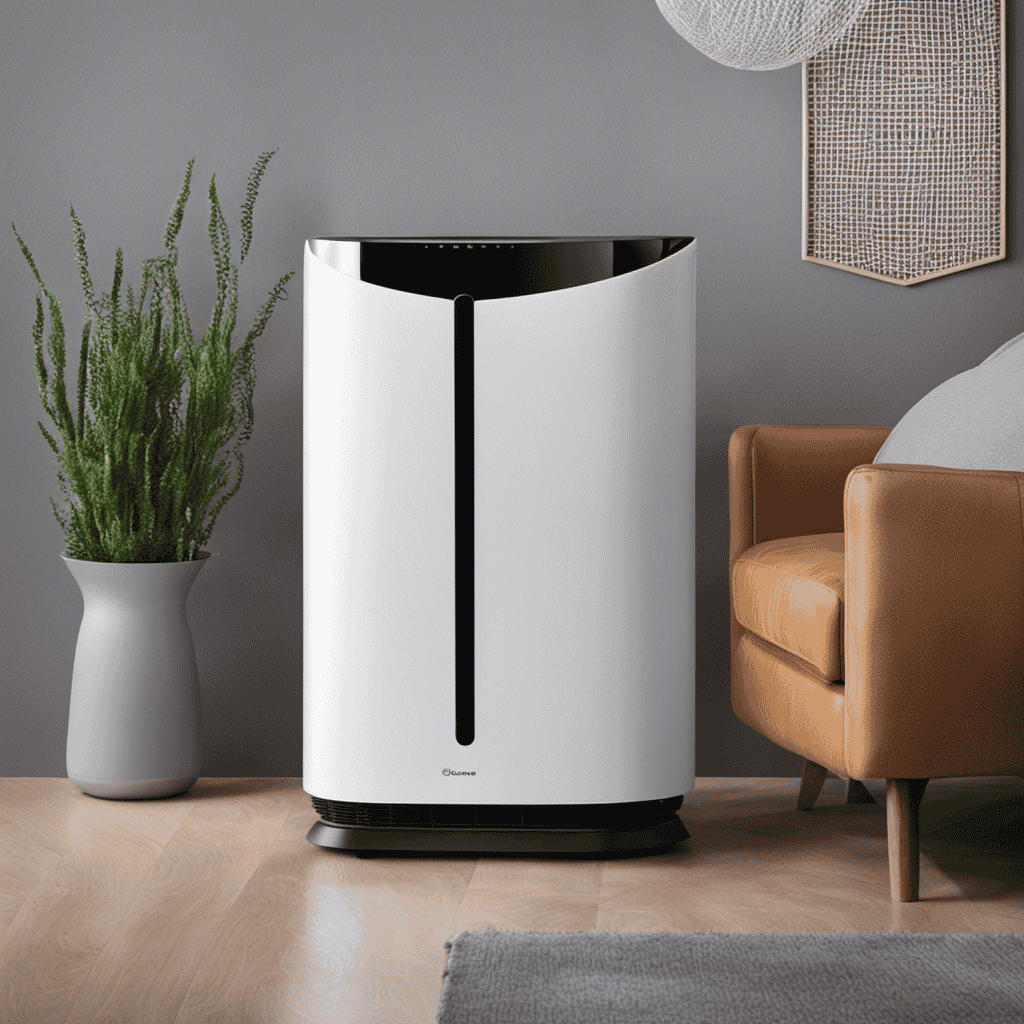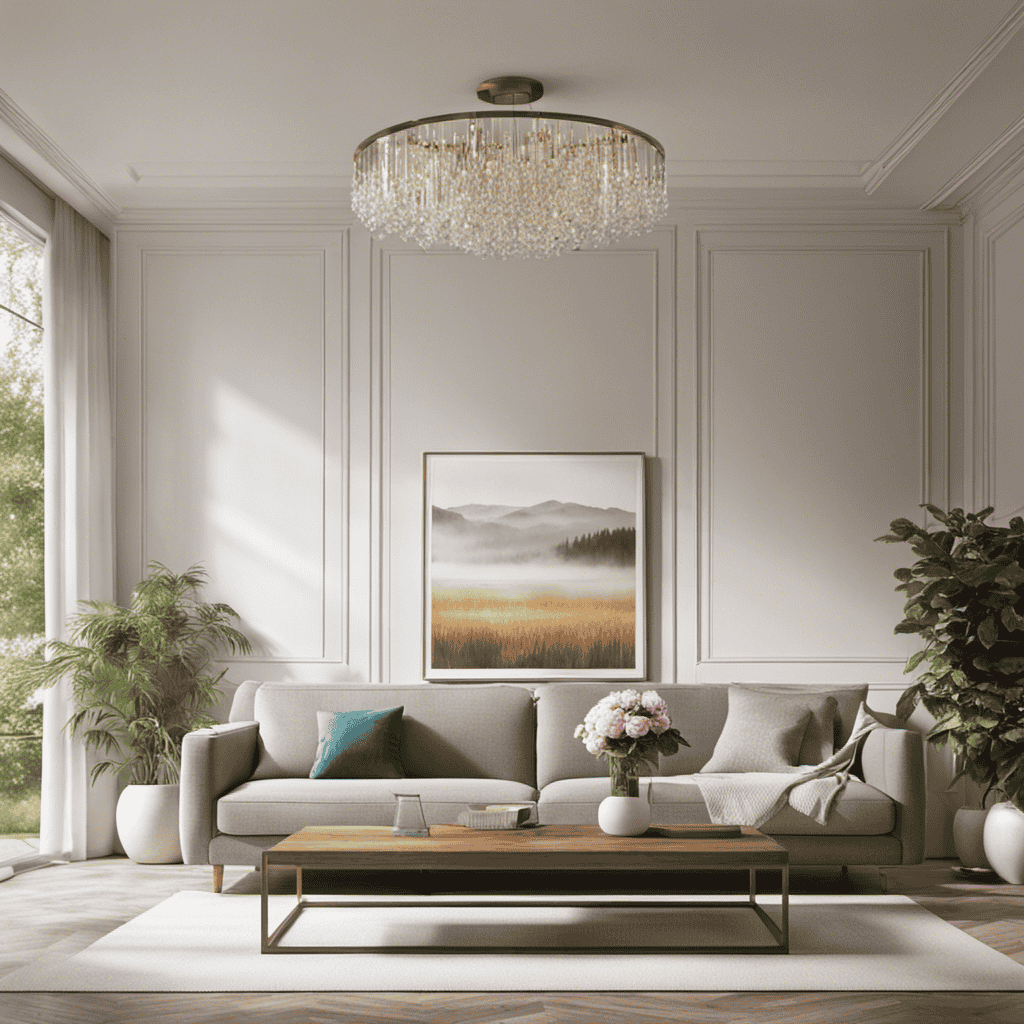Did you ever stop to think about why there is a strange white powder building up on your air purifier? I have the information you’ve been looking for.
In this article, we’ll delve into the fascinating phenomenon of white dust and explore the causes behind its presence on air purifiers.
Not only that, but we’ll also discuss the impact it can have on your indoor air quality and provide you with practical tips to prevent and remove this pesky dust.
So, get ready to uncover the secrets behind that perplexing white residue on your air purifier.
Key Takeaways
- White dust is formed when minerals in water used by humidifiers are released into the air.
- Inhaling large amounts of mineral particles can irritate the respiratory system and aggravate allergies and asthma symptoms.
- Lack of filtration in air purifiers allows mineral particles to circulate and accumulate, leading to white dust formation.
- Using distilled water in humidifiers and regularly cleaning air purifiers can help prevent and reduce white dust accumulation.
Understanding the White Dust Phenomenon
If you’re wondering why there’s white dust on your air purifier, it’s important to understand the white dust phenomenon.
White dust is a common occurrence in homes with ultrasonic humidifiers. This dust is formed when minerals, such as calcium and magnesium, in the water used by the humidifier are released into the air. These minerals settle on surfaces, including your air purifier, creating the white dust you see.
While white dust itself is not harmful, it can pose some concerns. Inhaling large amounts of these mineral particles can potentially irritate the respiratory system.
To prevent white dust from settling on your air purifier and other surfaces, you can use distilled water instead of tap water in your humidifier. Additionally, regularly cleaning and maintaining your air purifier can help reduce the accumulation of white dust.
Causes of White Dust on Air Purifiers
I’ve noticed that there is a white dust on my air purifier, and I’m curious about what could be causing it.
After some research, I’ve discovered that there are a few key factors that can contribute to the presence of white dust.
Firstly, the mineral content in the water being used in the humidifier can play a role, as minerals can become airborne and settle on surfaces.
Additionally, a lack of filtration in the air purifier can allow these particles to circulate and accumulate.
Lastly, high humidity levels can exacerbate the issue by increasing the amount of water vapor in the air, leading to more mineral deposition.
Mineral Content in Water
You’ll notice a white dust on your air purifier if the mineral content in your water is high. This white dust is a result of water hardness, which refers to the concentration of minerals, such as calcium and magnesium, in your water.
When hard water is used in humidifiers or air purifiers, the minerals in the water are released into the air as tiny particles, which then settle on surfaces like your air purifier.
Here are four key points about water hardness and its health effects:
-
Hard water can lead to the formation of mineral deposits in appliances, reducing their efficiency and lifespan.
-
The mineral particles released by hard water can irritate the respiratory system, leading to coughing, wheezing, and other respiratory issues.
-
These mineral particles can also aggravate allergies and asthma symptoms.
-
Ingesting hard water may contribute to an increased risk of developing kidney stones.
It’s important to consider the mineral content in your water and take appropriate measures, such as using distilled or filtered water, to minimize the white dust on your air purifier and potential health effects.
Lack of Filtration
Lack of filtration can lead to an accumulation of mineral particles in the air, causing potential health issues. Filtration systems, such as air purifier filters, play a crucial role in removing these particles from the air we breathe.
When filtration is inadequate or absent, mineral particles from various sources, such as dust, pollen, and industrial emissions, can circulate freely in the indoor environment. These particles may contain harmful substances such as heavy metals, bacteria, and allergens, which can trigger respiratory problems, allergies, or even chronic illnesses.
Air purifier filters are designed to trap and remove these particles, ensuring cleaner and healthier air. Regular maintenance and replacement of the filters are essential to maintain the efficiency of the filtration system and prevent the accumulation of mineral dust, safeguarding our well-being.
High Humidity Levels
High humidity levels can lead to an increase in mold growth, which can pose health risks and damage to buildings. To prevent these issues, it is important to control the humidity levels in your environment.
Here are four reasons why using a dehumidifier can be beneficial for mold prevention:
-
Health benefits: Excessive moisture in the air can trigger allergies, asthma, and respiratory problems. By reducing humidity, a dehumidifier helps create a healthier indoor environment.
-
Damage prevention: Mold can cause structural damage to buildings, leading to costly repairs. A dehumidifier helps to prevent mold growth and protect your property.
-
Odor control: High humidity can result in musty odors caused by mold and mildew. A dehumidifier helps eliminate these unpleasant smells, creating a more pleasant living or working space.
-
Improved air quality: By reducing moisture, a dehumidifier helps improve overall air quality, making it easier to breathe and reducing the risk of mold-related illnesses.
Investing in a dehumidifier is an effective way to prevent mold growth and enjoy the benefits of a healthier, more comfortable environment.
Impact of White Dust on Indoor Air Quality
The white dust from my air purifier can affect the quality of the air indoors. Not only does it have an impact on respiratory health, but it can also affect my household appliances.
When the air purifier releases white dust particles into the air, they can be inhaled and cause irritation to the respiratory system. This can lead to symptoms such as coughing, sneezing, and difficulty breathing, particularly for those with pre-existing respiratory conditions.
Additionally, the white dust can settle on surfaces and accumulate in the air ducts and filters of household appliances, such as HVAC systems and electronics. This can reduce the efficiency of these appliances over time and increase maintenance and repair costs.
Regular cleaning and maintenance of both the air purifier and household appliances can help mitigate the effects of white dust on indoor air quality and appliance performance.
How to Prevent White Dust Build-Up on Air Purifiers
Regular cleaning and maintenance can help prevent the build-up of white dust on air purifiers. Here are four steps to avoid white dust and keep your air purifier running efficiently:
-
Use distilled water: Tap water contains minerals that can leave behind white dust. Using distilled water eliminates this issue and ensures clean air circulation.
-
Clean the air purifier regularly: Dust and debris can accumulate on the filters, causing the release of white dust. Clean the filters as instructed by the manufacturer to prevent this build-up.
-
Replace filters when necessary: Over time, filters become clogged and less effective. Regularly check and replace filters to maintain optimal performance and minimize white dust production.
-
Keep the environment clean: Vacuuming and dusting regularly can reduce the amount of dust particles in the air, thus minimizing the white dust that settles on your air purifier.
Cleaning and Maintenance Tips for White Dust Removal
When it comes to preventing white dust build-up on air purifiers, there are a few key points to keep in mind.
First, it’s important to choose an air purifier with a built-in humidifier or use a separate humidifier in the room. This helps to ensure that the air in your home doesn’t become too dry, reducing the likelihood of white dust forming.
Secondly, regular cleaning and maintenance of your air purifier is crucial. By following effective cleaning methods, such as wiping down the surfaces and replacing filters as recommended by the manufacturer, you can minimize the presence of white dust and keep your air purifier functioning optimally.
Preventing White Dust
To prevent white dust on your air purifier, you should regularly clean and replace the filters. This is especially important if you live in an area with hard water. Here are some reasons why filter replacement is crucial:
-
Healthier Air: Clean filters ensure that the air you breathe is free from dust particles, allergens, and other contaminants.
-
Improved Efficiency: Clogged filters reduce the efficiency of your air purifier, leading to increased energy consumption and decreased performance.
-
Longer Lifespan: Regular filter replacement extends the lifespan of your air purifier, saving you money in the long run.
-
Peace of Mind: Knowing that you have clean filters in place gives you peace of mind, knowing that you are taking proactive steps to maintain a healthy indoor environment.
By following these tips and regularly replacing your air purifier filters, you can prevent white dust buildup and ensure the optimal performance of your air purifier.
Now, let’s explore some effective cleaning methods to remove existing white dust.
Effective Cleaning Methods
One effective way to clean and maintain your air purifier is by regularly wiping down the exterior with a damp cloth. This simple step helps to remove dust and dirt that may accumulate on the surface of the purifier.
Additionally, it is important to clean the filters of the air purifier regularly to ensure its optimal performance. Depending on the model, you may need to replace the filters or wash them with water and mild soap. It is recommended to consult the manufacturer’s instructions for specific cleaning instructions.
By following these effective cleaning and maintenance methods, you can ensure that your air purifier continues to function efficiently and provide clean air for your space.
Now, let’s explore some alternative solutions to minimize white dust from air purifiers.
Alternative Solutions to Minimize White Dust From Air Purifiers
There are a few ways you can minimize white dust from your air purifier. Here are some alternative solutions to consider:
-
Use water filters: Installing a water filter in your air purifier can help reduce the amount of white dust. These filters work by trapping minerals and other impurities present in the water, preventing them from being released into the air.
-
Clean regularly: Regular maintenance is essential to keep your air purifier functioning optimally. Clean the filters and other components as per the manufacturer’s instructions to prevent the buildup of white dust.
-
Natural remedies: Consider using natural remedies like essential oils or herbal sachets to add fragrance to your home instead of relying solely on your air purifier. This can help reduce the amount of dust particles in the air.
-
Adjust humidity levels: White dust is often caused by dry air. Using a humidifier in conjunction with your air purifier can help maintain the ideal humidity level, minimizing the formation of white dust.
Conclusion
In conclusion, the white dust phenomenon on air purifiers is a common occurrence that can impact indoor air quality. By understanding the causes of white dust and implementing preventive measures, such as using distilled water or demineralization cartridges, we can minimize the accumulation of this dust.
Regular cleaning and maintenance of air purifiers are essential for efficient operation and to remove any existing white dust. Remember, with a little care and attention, we can keep our air purifiers dust-free and enjoy fresher and cleaner air in our homes.
It’s like a breath of fresh air for our lungs!










